Chinese coal miner Baofeng Energy has announced the start of construction of what it claims will be the world’s largest solar-powered hydrogen plant, in the Ningxia Hui autonomous region of northwest China.
The RMB1.4 billion ($199 million) electrolysis project is intended to produce 160 million cubic meters of hydrogen per year plus 80 million cubic meters of oxygen. Baofeng said the use of solar electricity to power the facility would save 254,000 tons of coal consumption annually, leading to a 445,000-ton reduction in carbon emissions.
The project will feature two 10,000m3/hr electrolyzers powered by two 100 MW solar plants plus a 1,000kg/day hydrogenation station and two petrol stations will be converted to also supply natural gas and hydrogen for transport purposes. The solar panels will be installed over wolfberry and alfalfa crops which will generate extra revenue, according to Baofeng.
Popular content
Work on the project started this month and is slated for completion this year, with hydrogen production to start next year.
Baofeng is also working on a coking co-generation plant to produce three million tons of coal-based coke per year, plus 1.2 billion cubic meters of hydrogen.
This content is protected by copyright and may not be reused. If you want to cooperate with us and would like to reuse some of our content, please contact: editors@pv-magazine.com.


If they can build a hydrogen fuel cell into an automobile, they can build many of them on the ground, and use them to convert hydrogen to electricity. The hydrogen can be stored and transported by pipe just like electricity, but there’s no need for battery storage. 👍
I can see a use for hydrogen in applications such as seasonal storage for electricity grids and also potentially medium to long-haul trucking and aviation, where the very high utilisation rate and the need for higher energy densities makes it viable, given the very high cost of fuel cells, and despite the very low round-trip energy conversion efficiency. However, I question whether it will be attractive for typical passenger or short haul trucking because it is cheaper, easier and safer to charge a battery EV from one’s own home or facility’s solar generation/battery storage/grid electricity. In my case, I prefer being able to charge my EV from home very cheaply at any time of the day from a combination of my home solar PV and some grid electricity, the latter of which I pay a 25% premium for all of it to be generated or offset by 100 renewable energy. Secondly it allows me to pay for only 1 utility as I have a fully electric household.